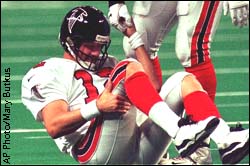 |
|
| | Thursday, October 21 | |||||||||||||||||||||||||||||||||||||||||||||||||||||||||||||||||||||||||||||||||||||||||||
Special to ESPN.com | ||||||||||||||||||||||||||||||||||||||||||||||||||||||||||||||||||||||||||||||||||||||||||||
| In the context of this strange NFL season, it figured that Terrell Davis was playing defense when his right knee exploded.
The Broncos lost their best player on the other side of the ball, linebacker John Mobley, with a similar injury in the season's second game. The Atlanta Falcons are without running back Jamal Anderson for the rest of the season after he sustained a knee injury almost identical to Mobley's. Quarterback Chris Chandler has been dogged by a hamstring injury. And so, the two teams that met in Super Bowl XXXIII eight months ago are 0-4. The Broncos and Falcons are the first two Super Bowl teams to start so dreadfully in a non-strike-shortened season. "Sick," Denver offensive tackle Tony Jones said. "Sick. Sickening." The first quarter of the 1999 season has been marked by high-profile, catastrophic injuries. Davis and Anderson, for instance, were the league's two most prolific runners last season. Consider these additional injuries:
What in the name of M*A*S*H is going on here? Is an injury epidemic sweeping the NFL? "No, not really," Colts president Bill Polian said. "I think injuries are down. It's just that they all happened in New York or to highly visible teams." The league declines to offer specific data regarding injury totals, but officials say that injuries are actually running behind the pace of a year ago. Still, the perception lingers that more football players are getting hurt. "The perception is always that way," said George Young, the NFL's senior vice president of football operations. "We live in a world of perception over reality. No one wants to listen to reality. If your team gets hurt, that's the perception. But that's not what's happening in the league." Both Young and Polian, however, acknowledge a new and disturbing trend. For a number of reasons, injuries to key players are more debilitating to a team than ever before. "There is no question that injuries have a greater effect under this present system," Polian said. "You have to go all the way back to the foundation level of building your team. The combination of expansion and the salary cap has thinned backup talent to the point it's nonexistent. "When you sustain an injury, there is every likelihood that whoever steps in won't even approximate the level of the player that went down."
Thin is in After every injury, large or small, league trainers are required to fill out a detailed form that can sometimes run two or three pages. Under the grim heading, "Case Abstract," categories include an injury description, diagnostic procedures, principal management, rehabilitation plans and protective equipment. The time of day, field surface condition, temperature and humidity, and whether the team was tied, ahead or behind at the time of the injury is noted. There is even a code for the particular stadium in which the injury occurred Every Wednesday, a video is circulated at league headquarters on 280 Park Avenue in New York. It includes all the controversial plays involving instant replay, flagrant penalties and injuries. "We are aware," Young said. "It comes up all the time. The last two preseasons, people wondered if injuries were up. A few years ago, when all the quarterbacks were getting hurt, there were questions. We look at it. "When you get down to it, injuries remain pretty constant. Hey, it's a tough sport. Guys are going to get hurt." A decade ago, teams that drafted wisely and nurtured young players could build a roster that was 35 players deep. Expansion -- three teams have been added in the 1990s, which brings another 150 players into the pool -- has made it harder to find quality backups who are invariably called on when injuries occur. The free-agency system and its daunting salary cap have made it difficult to adequately compensate players who aren't starters.
This, Ralph Cindrich knows. The well-respected player agent based in Pittsburgh played in the NFL for three teams from 1972-75. "We've lost something in the NFL, in my opinion," Cindrich said. "When I played, there were fewer jobs and more competition. I don't think you see as many of those guys who can play special teams, who are good locker-room guys but maybe not quite every-down players. When it's a choice of paying a veteran the minimum salary of, say, $400,000 versus the $175,000 a rookie gets, most teams will pay the rookie." With two-thirds of the league's teams up against the $57.3 million salary cap, not many can afford to go with quality backups. This time of year, Cindrich is usually placing fringe veterans on rosters when injuries start to pile up. This year? "I've got a handful of guys who should be on NFL rosters," Cindrich said, "and this year the opportunities are not opening up. It's a combination of fewer injuries and the cap."
Needing a backup plan The teams with solid backups have already seen their investments pay off. Would the New York Jets be 1-3 if the dependable Neil O'Donnell were the backup, instead of Rick Mirer? Instead, O'Donnell is in Tennessee, where the Titans are a tidy 3-1 despite the loss of Steve McNair. Can the Broncos realistically replace Davis, whose 6,413 yards were the third-best, four-season start in NFL rushing history, with Derek Loville? Will rookie linebacker Andy Katzenmoyer begin to compensate for the loss of Johnson in New England? Garcia has a chance to succeed in Young's place primarily because the 49ers' offensive system is so complementary; San Francisco's backup QBs are 27-10-1 since 1981 and have won four consecutive games. The laws of evolution and natural selection insist that players in the league get bigger, faster and stronger over time. Collisions are, by the definitions of physics, more violent and more damaging. The stress and torque placed on ligaments, muscles and tendons is enormous. When depth is paper-thin, even the best teams can be brought down by a few critical injuries. The four teams from last year's conference championship games (Atlanta, Minnesota, Denver and the Jets) are a collective 3-13. The Cardinals, who have been hamstrung by injuries are a disappointing 1-3. Dallas and St. Louis are, against the odds, the league's only 3-0 teams. The 4-0 Patriots? They've trailed at halftime in each of their four games. "Your margin for error is less," Polian said. "The field is a lot more level than it used to be." | ALSO SEE While Young ponders retirement, 49ers consider cap
Bronco bummer: Davis out for year with knee injury
Falcons lose Anderson for season with knee injury
Jets' Testaverde out for year with Achilles injury
AUDIO/VIDEO   Terrell Davis talks about his injured knee. Terrell Davis talks about his injured knee.wav: 258 k RealAudio: 14.4 | 28.8 | 56.6  Trainer Steve Antonopulos is confident. Trainer Steve Antonopulos is confident.wav: 97 k RealAudio: 14.4 | 28.8 | 56.6  | |||||||||||||||||||||||||||||||||||||||||||||||||||||||||||||||||||||||||||||||||||||||||||

